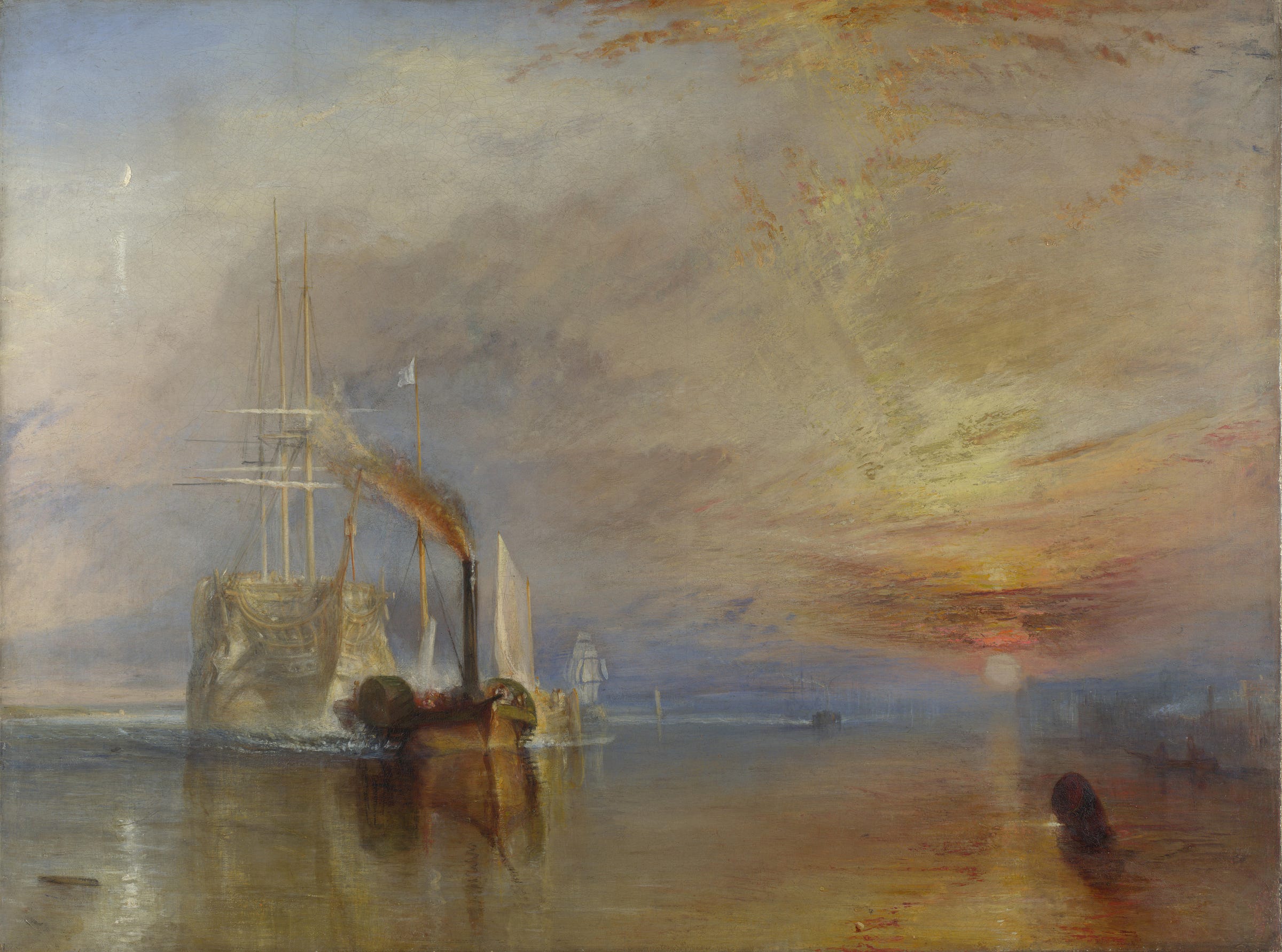
The 250th anniversary of the birth of Joseph Mallord William Turner (British, 1775-1851) is being feted with an international slate of exhibitions and I Require Art is joining the celebration. Though Turner produced his works in an earlier period than we usually share here on Substack, without this extraordinary artist, the development of Modern painting would have been far slower. Turner’s handling of paint and color was an inspiration to the French Impressionists (especially Claude Monet) and the painter color in his works encouraged later artists drawn to abstraction. In a March Viewing Room, I shared my experience of Turner’s watercolors at the Taft Museum in Cincinnati, in an exhibition that continues through June 15. In this edition of Chance Encounters, I will explore a selection of the artist’s oil paintings.
I have no secret but hard work. … Labor is the genius that changes the world from ugliness to beauty, and the great curse to a great blessing. – JMW Turner
Turner, painter and printmaker, produced an impressive body of work over his 60 year career. His more than 550 oil paintings, 2000 watercolors, and 30,000 works on paper demonstrate his life-long commitment to his craft. The work above depicts the Temeraire, a ship at the end of its useful service being towed to be dismantled. This painting has been voted “Britain’s Favorite Panting” and now graces Britain’s 20-pound note. When he created this work in 1839, the artist had been exhibiting at the Royal Academy for 40 years. The painting was immediately acclaimed, both for its beauty and its theme, which struck a patriotic chord for British viewers. The Temeraire had been among the British ships under Admiral Horatio Nelson at the 1805 Battle of Trafalgar, which had established Britain’s naval dominance over France and Spain.
The composition of this painting is unusual as the ship and its companion tugboat are far to the left, balanced by the setting sun and a bit of shoreline on the right. The Temeraire is painted in mostly white, making it ghostly, as if already only a memory. The setting sun may symbolize, not only the ship’s end, but the end of the era of sailing ships. The dark tugboat seems more solid, and its flaming smokestack echoes the colors of the sunset. With this painting, the artist contrasts the past and present, but it is unclear whether he is bemoaning the lost past, lauding the rising Industrial era, or perhaps some of both. Turner called this painting his “darling” and maintained possession of it until his death.
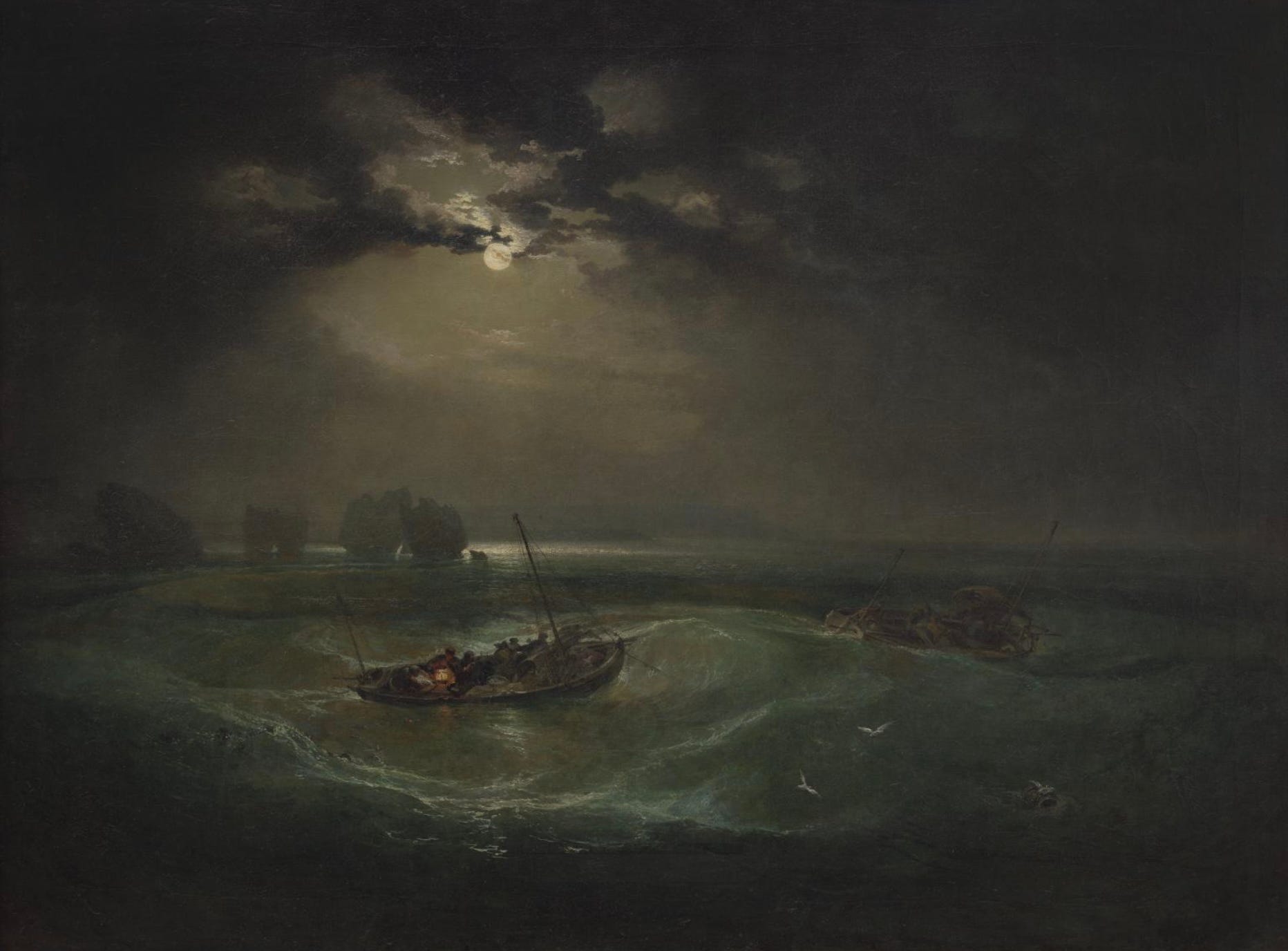
Turner was born to a lower-middle class family and never developed a taste for the trappings of wealth and fame, though he earned a reliable income from his work throughout his life. The young artist worked as a draughtsman for architects and studied with a popular painter of London views. He even began to receive commissions in his early years as a student. Turner was a child prodigy, entering the prestigious Royal Academy of Art at the age of 14. He exhibited his first work, a watercolor, in the important Summer Exhibition when he was 15. The artist’s first oil painting to be exhibited at the Academy was Fishermen at Sea, in 1796. Set off the Isle of Wight, the painting established Turner’s reputation as a marine painter and the theme of boats in peril is one to which he would frequently return. The dramatic contrast between moon and clouds is an early example of Turner’s passion for light effects.
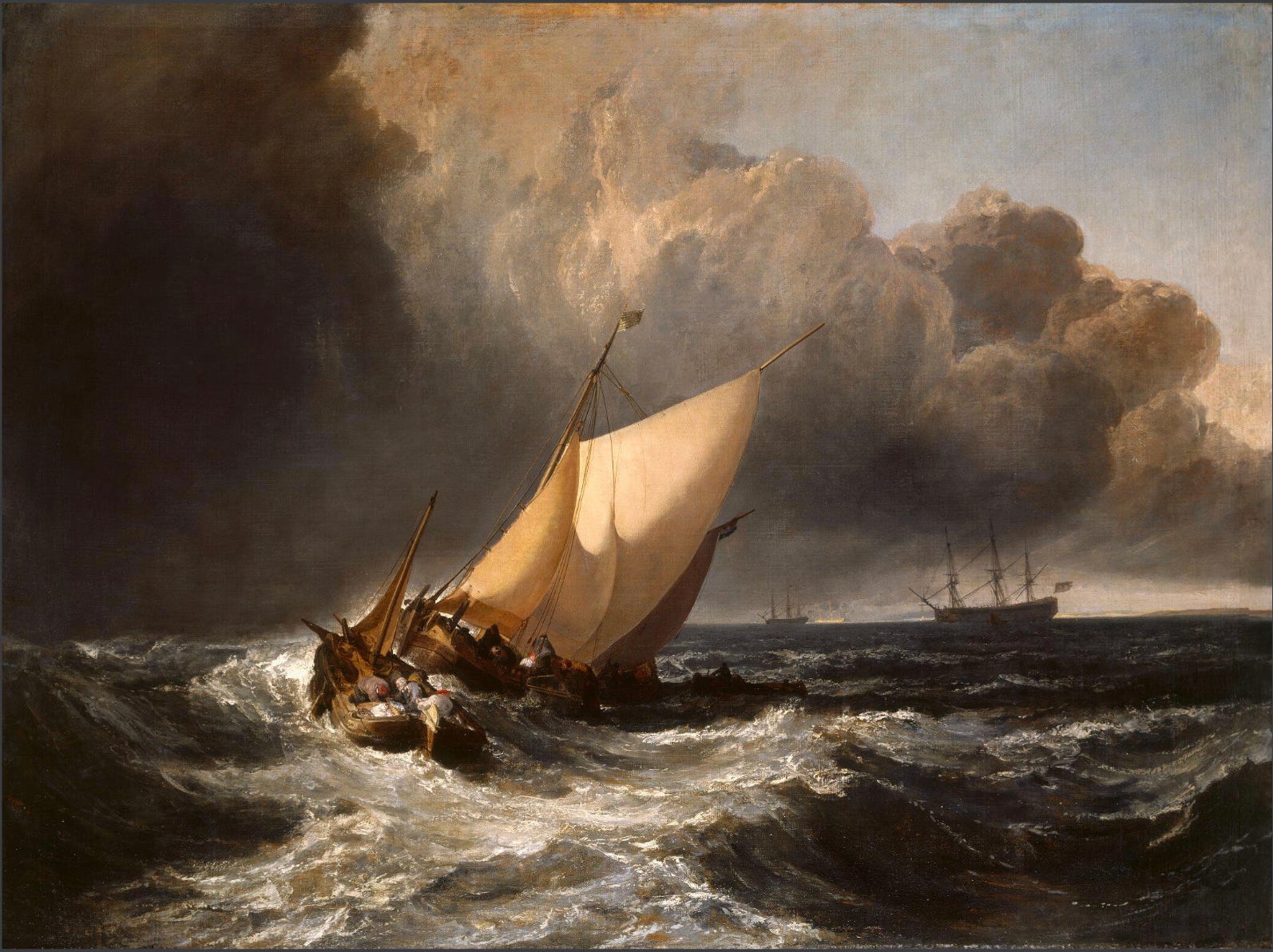
Five years after Fishermen at Sea, Turner returned to the subject of man’s struggle to survive the dangerous ocean in Dutch Boats in a Gale. This painting was commissioned by the Duke of Bridgewater as a companion to a 17th century Dutch sea painting in the duke’s collection. Turner clearly looked as closely at boats and ships as he did at nature. The structures of the small fishing boats in the foreground, down to the rigging of their sails, are carefully depicted, and easily seen by the viewer since the artist has placed them in the last shaft of light before the dark clouds overtake the boats. The unsteadiness of the smaller boats is contrasted with the more stable, large ships in the distance, but the coiling dark clouds are headed towards them too. Turner’s landscapes, even at this early stage of his career, demonstrate the Sublime: humanity’s powerlessness in the face of Nature, an important theme of 19th century Romanticism.
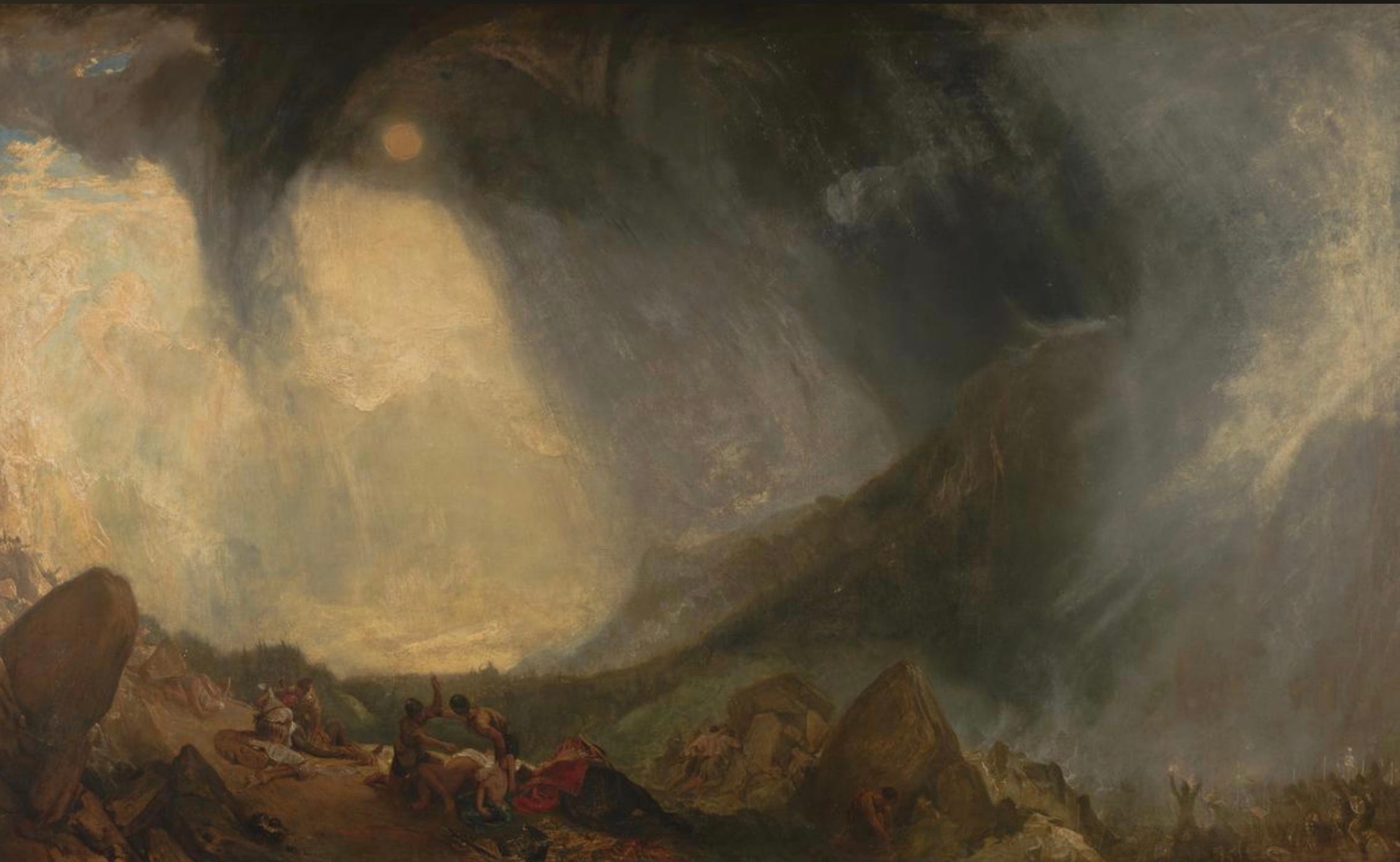
Turner was interested in lifting landscape from its status as mere scene painting. Prior to the 17th century, the only purpose for landscape in European art was as a backdrop for portraits, historical subjects, or religious scenes. By the 18th century, landscape was accepted as an independent genre or theme, but it wasn’t considered to have the same cultural weight as religious or history paintings; such large scale figural subjects with moral messages were seen as the highest achievement of the painter’s art. With works like Snow Storm: Hannibal and his Army Crossing the Alps (1812), Turner began to create large scale landscapes into which he introduced important historical and mythological subjects. The figures in these paintings are dwarfed by the dramatic power of nature, but they aren’t merely providing visual interest. The historical theme and the landscape work together to convey the significance of the event shown. Modern scholars consider Turner to have achieved his goal of raising landscape to the equal of history painting.
To select, combine and concentrate that which is beautiful in nature and admirable in art as is much the business of the landscape painter in his line as in other departments of art. – JMW Turner
The artist began to travel to continental Europe around 1802, often bringing back sketchbooks packed with drawings and watercolor sketches of what he had seen. He would then incorporate these records into his paintings, sometimes many years later. In the case of Snow Storm, however, the image is thought to have been inspired by a storm Turner witnessed while visiting friends in Yorkshire.
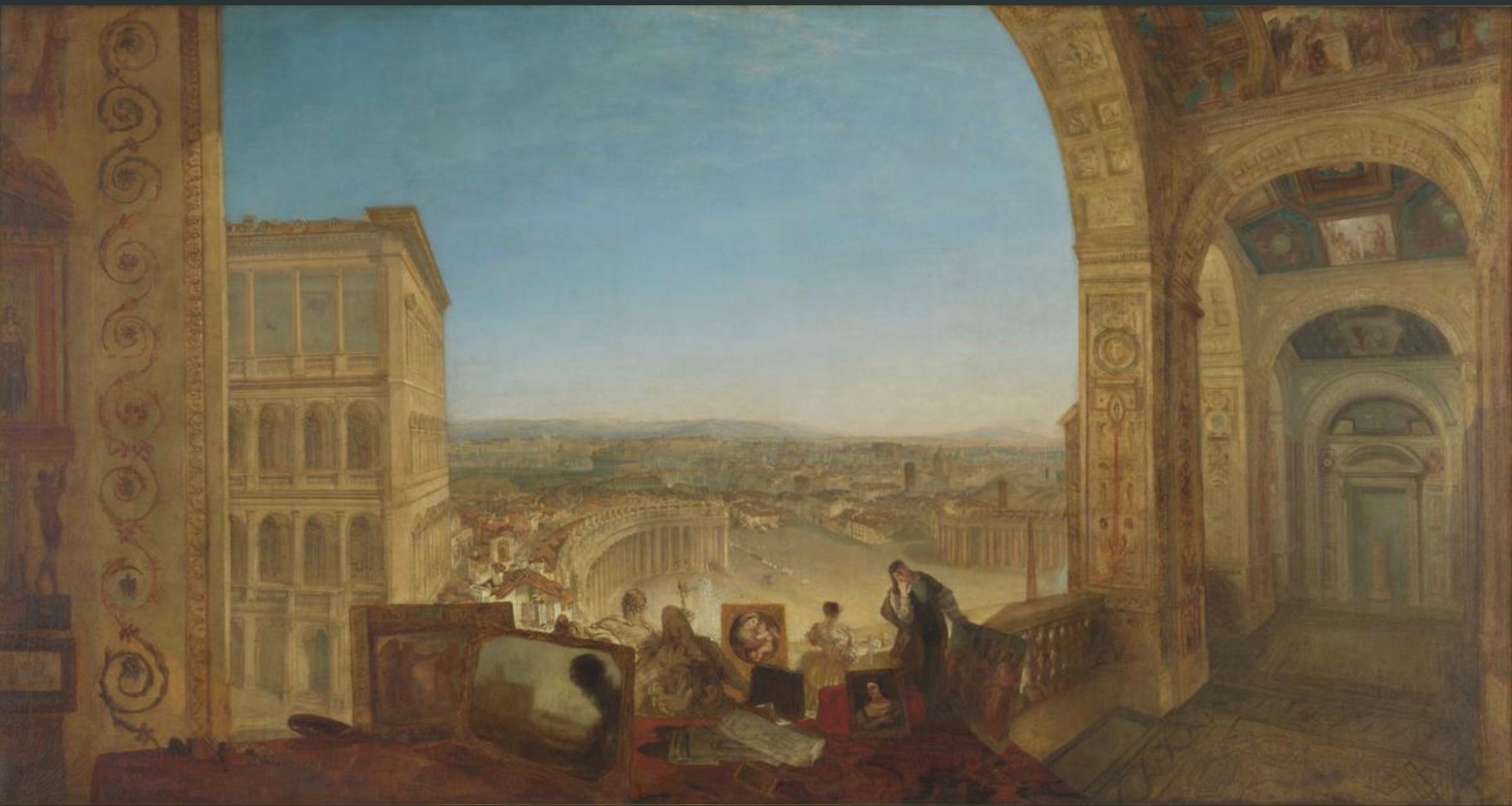
In Rome, from the Vatican (1820), Turner incorporates an art historical moment into the foreground of what would otherwise be a typical picturesque view of the Eternal City. A standing male and seated female figure are seen among a group of paintings at the lower center of the composition. tThe subtitle identifies them as the Renaissance master Raphael and his purported mistress, La Fornarina (the Baker’s Daughter) and Raphael’s Madonna and Child with Saint John (Madonna della Seggiola, c. 1513-1514) is clearly visible near the center of the grouping. Turner painted this work on his return from a visit to Rome, and first exhibited it on the 300th anniversary of Raphael’s death.

In 1834, the British Houses of Parliament caught fire and burned through the night. Along with many others, Turner spent the night watching the fire, moving to various vantage points as the night continued. He created numerous sketches, including some in watercolor, capturing the devastating fire. Afterward he created two oil paintings of the fire, both of which ended up in American museum collections. The work above, at the Philadelphia Museum of Art, depicts the fire from across the Thames with Westminster Bridge looming at the right. The second painting, now in the collection of the Cleveland Museum of Art, takes a more distant view, with the fire centered in the composition. In both works, the destructive power of the fire is expressed by the disappearance of the architecture into masses of vivid red and yellow. In the Philadelphia version reproduced here, the fiery distance is reflected in a deeper red on the river’s surface. Between the viewer and the fire, crowds spread across the riverbank and fill boats on the river, watching the spectacle. On the right side of the painting, cool white street lamps lining the bridge echo tiny white stars in the blue sky, providing a dramatic contrast of mood. Turner, whose earliest studies were steeped in accurate depictions of architecture and linear perspective, radically distorts the shape of the bridge as it approaches the fire, as if the heat and flames are actually consuming the bridge (which they did not).

One of Turner’s most memorable and discussed works, Slavers throwing overboard the Dead and Dying (known as The Slave Ship, 1840) was inspired by a despicable historical event aboard the ship Zong. Carrying enslaved Africans to Jamaica and running low on drinking water, the ship’s captain ordered some of the captives thrown overboard. Losses at sea could be claimed from the ship’s insurers. The events on the Zong were publicized in England and a court case ensued. Though the case was dismissed, the publicity brought public support to the movement to abolish slavery. The long road to complete abolition of slavery in Britain ended in 1833 and members of the movement, including JMW Turner, became interested in extending abolitionism internationally. Turner exhibited The Slave Ship in 1840, coinciding with two important anti-slavery conventions in London. In that context, the painting’s emotional landscape would have been seen as a call to action.
At first glance, one notices the sea, the sky, and the setting sun. Closer observation reveals the masts of a ship sailing toward the left, turned deep red by the sun. The sun sets the sea on fire and the ship seems to escape the flames into an area of cool blues and grays. In Turner’s telling of the story, this is a storm which has led the ship’s crew to cast its cargo, enslaved people, overboard. In the foreground, sketchily described body parts and chains can be seen sinking among fish and birds. At the right, a monstrous fish, cartoonish to modern eyes but undoubtedly frightening to 19th century audiences , swims toward the unfortunate victims. Turner wasn’t attempting to capture a lifelike record of the historical events. Instead, following the philosophy of Romanticism, he is using landscape to express the violent destruction of human life, to provoke an emotional response. In the centuries since the painting was first completed, it has inspired strong commentary on the suitability of such a subject for such a style. For John Ruskin, the 19th century British art critic, this was Turner’s greatest painting with its “thin masts written upon the sky in lines of blood.” Other critics have decried the painting’s lack of narrative clarity, a perceived over-emphasis on aesthetic concerns, and the dehumanization of the victims of slavery. Understanding the context of the work and the painting’s place in Turner’s career and art history generally has helped me to see The Slave Ship as I think the artist intended me to, but I acknowledge the difficulties the painting presents to other viewers.
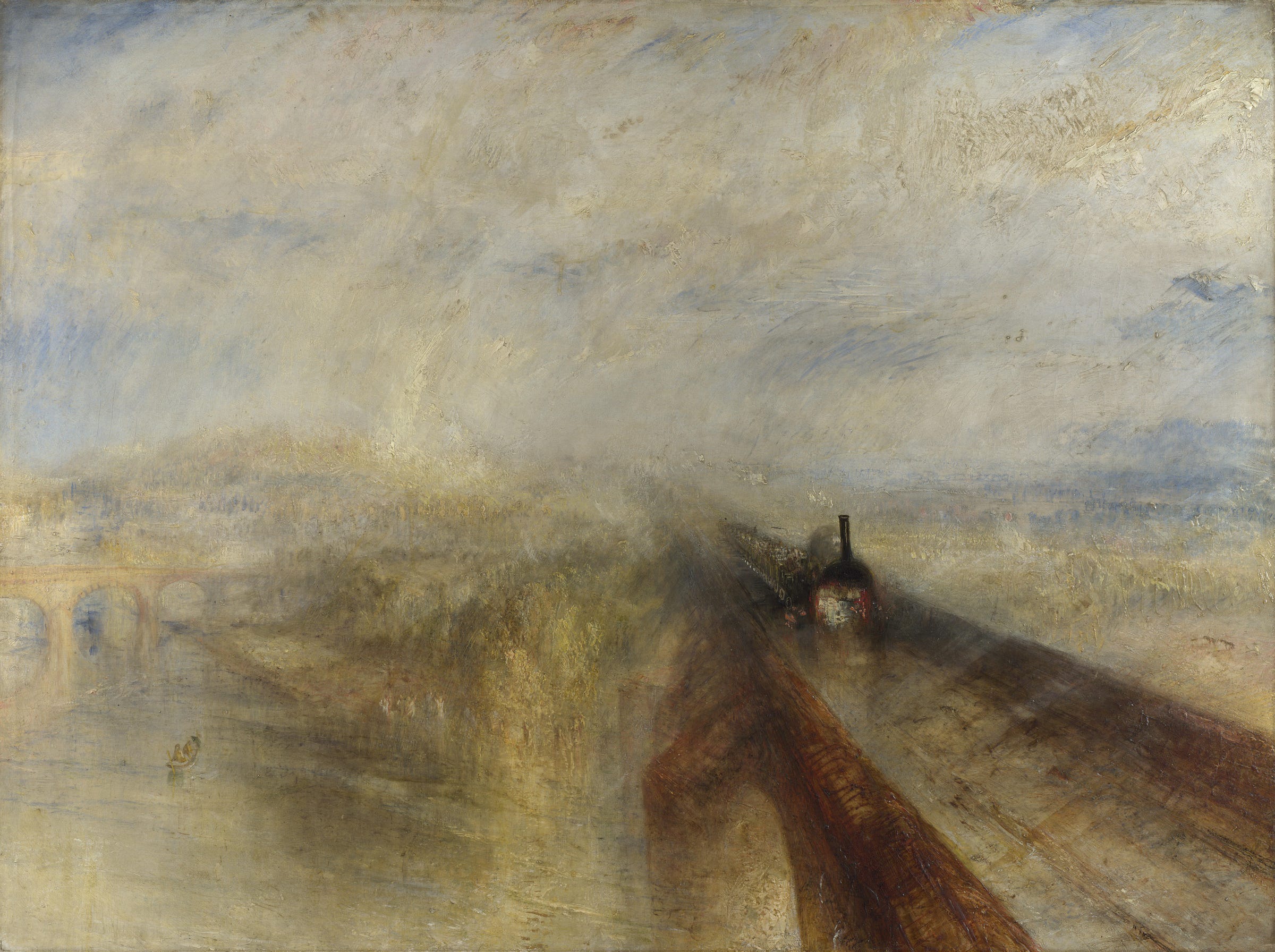
I first fell in love with Turner’s paintings as an undergraduate student viewing 35mm slides in an alternately drafty and stuffy old lecture hall. Ruskin certainly shared my admiration for this artist who he thought could “stirringly and truthfully measure the moods of Nature” but other critics of their day complained of the “blots” and “absurd extravagances” of the artist’s late paintings. Of the works I saw during that long ago class, none attracted me more than Rain, Steam and Speed – The Great Western Railway (1844). Turner’s late works are his most atmospheric and least concrete, yet close observation reveals subtle details that convey the artist’s enduring fascination with the modern landscape. To the right, a railroad bridge carries a steam locomotive pulling a string of packed cars as it speeds toward the viewer. In the mist to the left, an older road bridge is visible. In the river between the two bridges is a small boat, occupied by two figures and faintly seen figures along the riverbank wave at the train’s occupants above. To the right of the train, now barely visible, a hare races alongside the train. The hare, and perhaps other details, were likely more visible originally. Turner chose his paints according to what would look best when the work was completed, sometimes applying pigments known to be fugitive (susceptible to fading). The artist applied patches of thicker paint (impasto) to suggest the misty rain, the reflections of patchy sunlight, and especially the front of the locomotive and a few puffs of steam above it (see the gallery below).
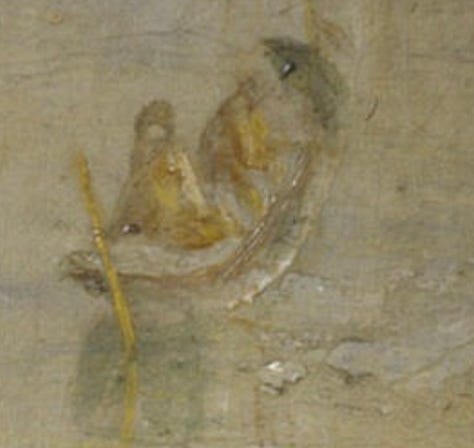
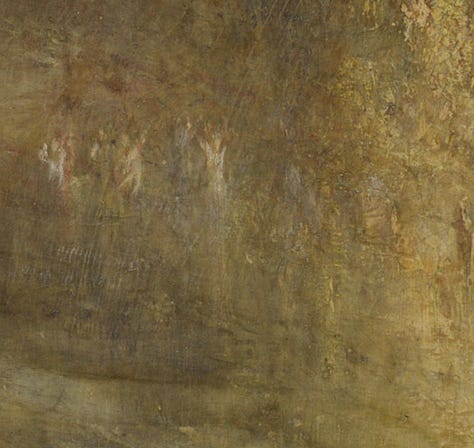
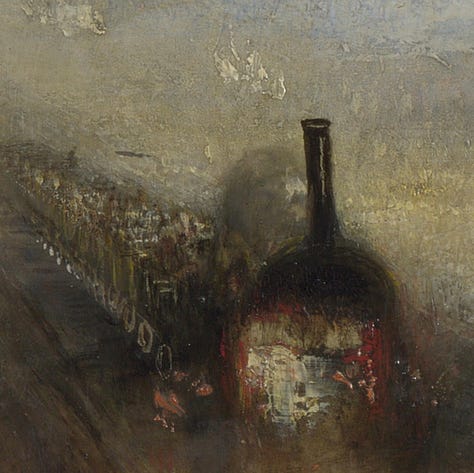
Turner began his career in the early years of the Romantic movement and grew to be a powerful master of evocative, expressive landscape painting. He evolved an array of landscape modes which he designated Marine. Mountainous, Pastoral, Historical, Architectural, and Elevated or Epic Pastoral, with which he could express complex emotional and philosophical meanings. By the end of his career, he had moved beyond Romanticism to a kind of proto-Impressionism which he produced twenty years before the French Impressionist artists developed their philosophy. For early 20th century artists exploring abstraction, Turner’s style provided plenty of examples of the ability of colorful paint to express the artist’s ideas. Close-up photographs of some of Turner’s impasto passages could easily be mistaken for Abstract Expressionist paintings of the mid-20th century.
No matter the stage of his career, Turner sought to touch the viewer’s soul, engage their senses, and provoke in them thoughts on the power of nature and the meaning of history. During the coming months, multiple exhibitions and events will celebrate the artist and his legacy of dramatic beauty. A list is included below. If you are able to visit any of them, I hope you’ll come back and share your thoughts with us.
Your likes and comments are a welcome recognition of our work. Thank you for reading and subscribing.
Current celebrating Turner 250
Turner Galleries, ongoing. Tate Britain, Millbank, London, England, UK. https://www.tate.org.uk/visit/tate-britain/display/jmw-turner
J. M. W. Turner: Watercolor Horizons, through June 15. Taft Museum of Art, 316 Pike Street, Cincinnati, Ohio, USA. https://www.taftmuseum.org/exhibitions/turner250
J. M. W. Turner: Romance and Reality, through July 27. Yale Center for British Art, 1080 Chapel Street, New Haven, Connecticut, USA. https://britishart.yale.edu/exhibitions-programs/j-m-w-turner-romance-and-reality
Turner’s Kingdom: Beauty, Birds and Beasts, through October 26. Turner’s House, Sandycombe Lodge, 40 Sandycoombe Road, Twickenham, UK. https://turnershouse.org/whats-on/
Turner; In Light and Shade, through November 2. The Whitworth at the University of Manchester, Oxford Road, Manchester, England, UK. https://www.whitworth.manchester.ac.uk/whats-on/exhibitions/turnerinlightandshade/
Upcoming exhibitions
Austen and Turner, May 2 to October 19. Harewood House, Harewood, Leeds, UK. https://harewood.org/events/austen-and-turner-a-country-house-encounter/
Impressions in Watercolor: Turner and his contemporaries, May 23 to August 31. Holburne Museum, Bath, UK. https://holburne.org/events/impressions-in-watercolour-turner-and-his-contemporaries/
Turner’s Vision at Petworth, June 21 to November 16. Petworth House and Park, West Sussex, UK. https://www.nationaltrust.org.uk/visit/sussex/petworth/turners-vision-at-petworth
Turner: Always Contemporary, October 25 to February 22, 2026. 26 Walker Art Gallery, William Brown St., Liverpool, UK. https://www.liverpoolmuseums.org.uk/whatson/walker-art-gallery/exhibition/turner-always-contemporary
Turner and Constable, November 27 to April 12, 2026. Tate Britain, Tate Britain, Millbank, London, England, UK. https://www.tate.org.uk/whats-on/tate-britain/turner-and-constable
Turner 250: Breaking Waves, through April 19, 2026. Turner Contemporary, Rendevous, Margate, Kent, UK. https://turnercontemporary.org/whats-on/turner-250-breaking-waves/

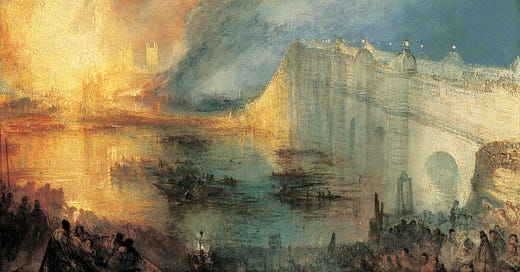


Thank you for all your research on Turner. I love the way you explained each painting, it was like a puzzle being solved.
Wonderful piece, thank you. Turner is such a marvel. Rain, Steam and Speed, new to me, is an extraordinary painting—and I so appreciate the details you included to give us a closer look.